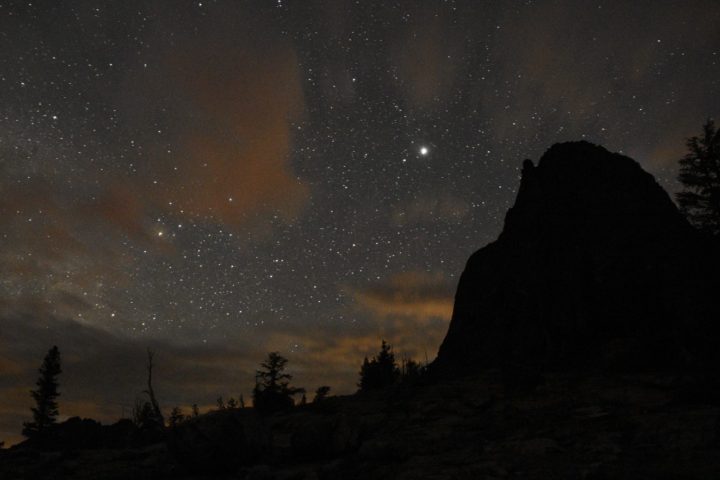Cell Phone Coverage.
On this trip, I travel with the Ansel Adams crowd rather than the John Muir crowd; nature photographers who want to capture an aesthetic on film rather than naturalists seeking a deep spiritual connection with the wilderness. Of course most everyone has some degree of both but there are telling differences on one’s predilection. The trail to Minaret lake shadows Minaret Creek heading due west never losing line of sight with Mammoth mountain and the Devil’s Postpile area. Cell phone coverage was five bars at the top of the mountain while only one bar at the base. If you think that is a good thing, you fall in the aesthetic category. If you think that is a bad thing, you fall in the spiritualist category.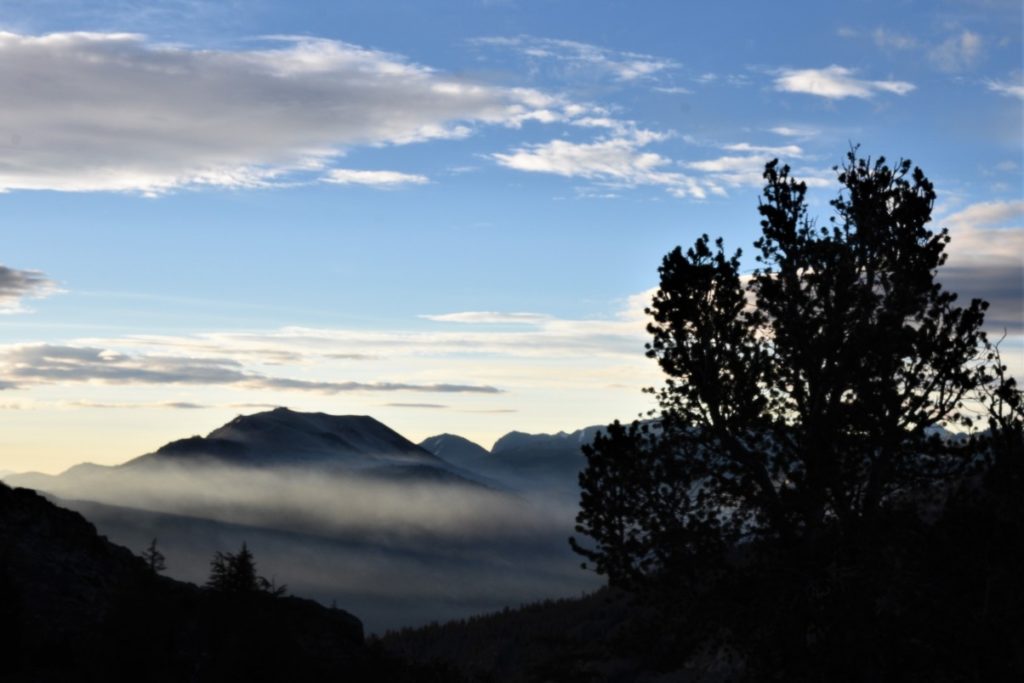
I’m not here to judge, just to tell a story. Now, I turned my cell phone off, for most of the trip anyway. I usually keep it on because I like to snap fast pictures while hiking. I hate stopping, taking the backpack off, pulling out the camera, setting up, putting it all away. Hiking requires psychological momentum especially when you are hauling an extra fifty pounds of gear on your back. I started with the phone on for fast pictures. The cell phone surprised me with its little notification dings continuing as we progressed up the trail. So I turned it off. No dings, no digital map, no GPS, no alarm, no messenger, no chat, no phone.
On the way back, I decided to break the moratorium for some fast pictures. Instead I found a barrage of messages. My son reports that Guera is foaming at the mouth, Maruka is acting weird, and the house stinks. That was twelve hours ago. My own mouth foams at the stupidity of my dogs for getting skunked for the fourth time. I don’t even finish reading his messages when I get a panicked phone call from my neighbor. Maruka keeps escaping somehow, the dog is overheating from the 107 degree Santa Ana heat in Escondido, and the dog is stinking up her house. I tell her to use the gate on the porch to keep Maruka from getting out of the house into my yard to escape into hers and I’ll send my son over there as soon as possible. My son’s idea of as soon as possible isn’t quite the same as mine. After accepting my request to get over to my house, he calls me back to tell me he went back to sleep and doesn’t want to go over until six at night when he has a car. I’m worried about the air conditioner not kicking on, my neighbor being traumatized, the stink of the house, and the general condition of the dogs. I persuade my reluctant son to uber over to the house.
So now I am in two places at once. I’m trying to manage my problems at home while enjoying the hike back to the car. I’ve disconnected. My pace has increased substantially. As my friend puts it, “Who put a battery in your ass?” I’ve been supercharged by a cell phone. If I had left my cell phone on, I would have disconnected from the trip twelve hours earlier. I would have preferred to keep my cell phone off, or at least in airplane mode. I really can’t do anything until I hike the eight miles out and drive the eight hours home. I’m not quite spiritual but when I go to the wilderness, I want to focus on the wilderness set of challenges and problems; not on the everyday set of challenges and problems. I think that is the point of going to the wilderness in the first place. It means trust in my support at home. It means a zen focus on the moment. Am I being responsive by managing a situation that needs my input? Which is more connected? I don’t think there is a bottom line.
Mosquitoes
Which is a nice segue into the problems. I did not prepare properly for mosquitoes. I tried to buy some Off at the convenience store but they only had the big cans. I didn’t think it was worth the extra weight so I passed on the opportunity. So I had to borrow repellent from my friend. When I borrow, I’m reluctant to abuse the use to the point of not using enough. I don’t think it would have much of a difference. I have no delusions about who is the predator and who is the prey. With all the standing water and the warming temperatures, hoards of hungry mosquitoes stalk their prey where ever he may walk. I’m killing three and four mosquitoes with one slap. Wiping under one arm with the other hand to get at skin I can’t see, I come up with an unknown number of rolled up mosquito carcasses. One flies into my nose, another into my eye, one into my macaroni, one into the boiling hot water on the burner. Some spots are worse than others but they seem to find me no matter where I go.
Its not the worst mosquito swarm I’ve ever encountered. On a bike trip that took me through Havre, Montana, I stopped in front of store for a food break. A cloud of mosquitoes surrounded me almost instantly and I pedaled away as fast. I’ve since heard from a transplanted Havrian, that Havre is known as mosquito hell. If hell hath levels, I would rate Alaska number one. From the east-west gravel road that winds through Denali, I hiked down into the braided Teklanika river basin. I remember worrying about bears but bears have nothing on the masses of underfed mosquitoes that could obscure a body within one. If I had stayed for longer than five minutes, my pale lifeless corpse would have been sucked dry. I don’t know animals can live there.
Once my friend told me he wouldn’t do the planned hike to Iceberg Lake because of his knee, I proffered a new plan to leave the next day. You have to understand the daily rhythms of the photographer. They set up the first shots at five in the morning to catch the ten minutes of mountain reflection, complain about the overhead lighting from the sun for the next twelve hours, then take another round of pictures at sunset to again catch the few moments of mountain reflection. The thought of spending twelve hours in my bivy to protect myself from mosquitoes in the surprisingly hot sun was way more spirituality than I wanted to absorb on one trip. I took every opportunity to slap at the mosquitoes in the presence of my friends to make sure they feel my pain.
I didn’t find out about the skunk until we already decided to hike out. I think I would have been crawling out of my skin if I had to worry about my house, my dogs, and my neighbor while mosquitoes sipped desperately at my boiling blood through the thin netting of my bivy.
Ansel Adams
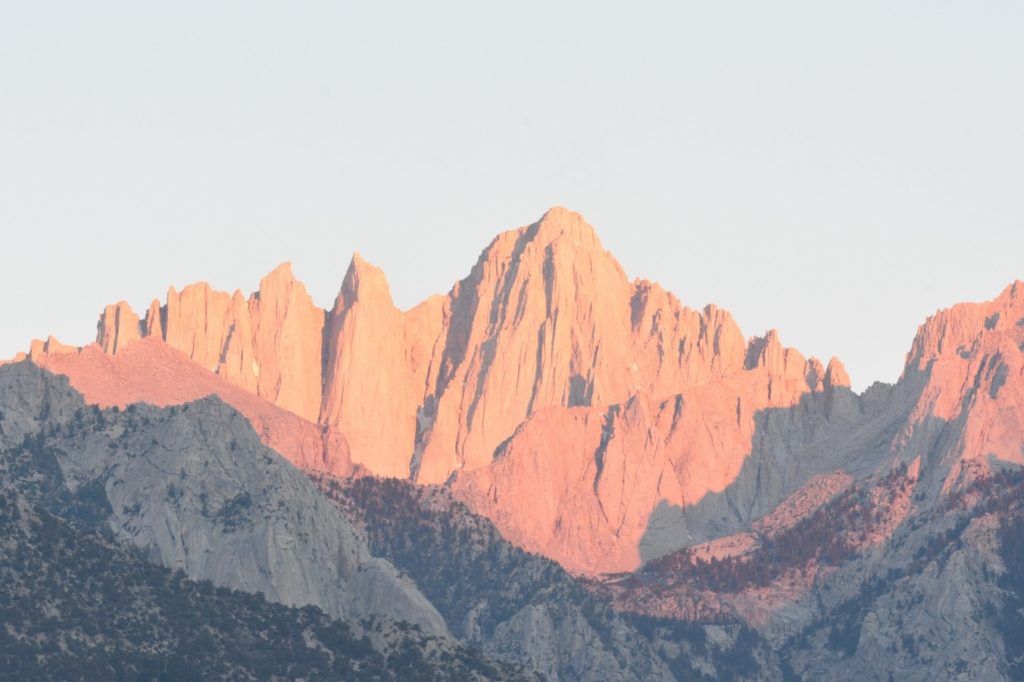
I instantly recognized the Minarets and Mt. Whitney photographs from the Ansel Adams collection as shown on Google images. I took the very same shots of Whitney on the ride up. The profile of Whitney and the island, the lake, the spires of the Minarets haven’t changed in fifty or sixty years. Ansel Adams pioneered landscape photography. Without knowing it until I looked at his photos, I suppose I one of his students, at least one of the many second and third off, that venture into the wilderness to duplicate his seminal efforts.
Ansel Adams wrote that black and white expresses color better than color does. He took color photos. He liked black and white better. Our compositions of Whitney and the Minarets are all about the color. We took our pictures at sunset and sunrise to capture the reds and pinks and deep yellows captured by the peaks. It didn’t even occur to me to turn them into black and whites. I don’t know if Adamizing a photo forces you to compose the picture differently to bring out all the subtleties of grey. Or perhaps it forces the photographer to focus more on the composition more than the wow. If I don’t have to get up at five in the morning to get a stunning picture, consider me a convert.
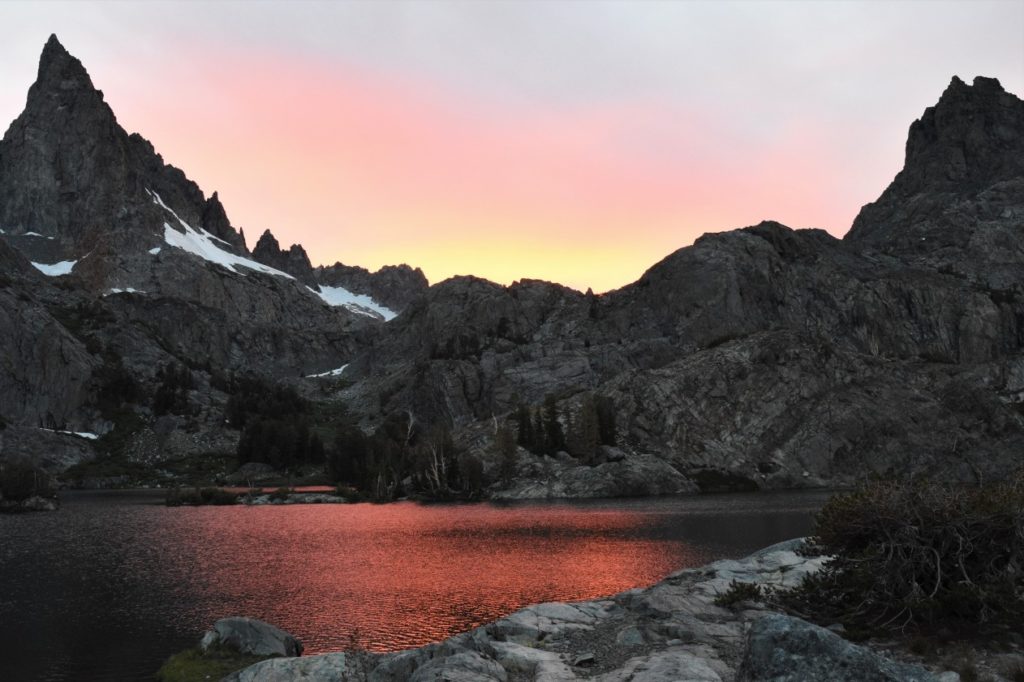
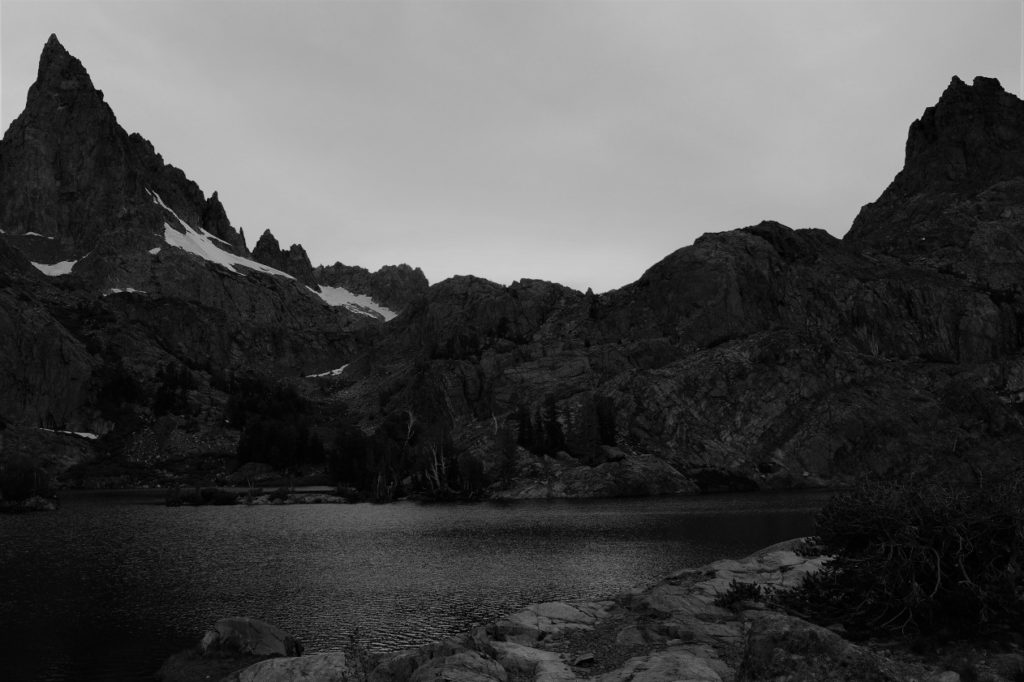
Digital changed photography. Ansel Adams used actual film and photoshopped his pictures, so to speak, in the developing lab. If he practiced thoughtful composition, I practice trial and error. I take as many pictures as possible knowing one of them is bound to turn out well. I don’t know if I practice art or luck. The camera provides instant feedback on the composition so I can rearrange compositions over and over hoping to achieve a balance though I have trouble seeing the tiny screen with my very poor reading vision. My camera provides useful lighting feedback when I snap a picture which I use to adjust setting in overexposed areas. I can retake the same picture over and over until I get the exposure I want. If I had the patience, I could stitch together the different exposures to get balance light everywhere in the photo with post processing tools. The iPhones already have an automated setting for combining exposures. I know the better photographers find the compositions and work the equipment much better than I do. The latter is technical proficiency but great artists know their paints and techniques. Is that any different?
Art or not art? Is photography art? Is art something that has to be good to be considered the thing that it is? Ansel Adams seemed to think the former: “You make a picture, you don’t take it.” So is my digital photography art or trial and error? I take pictures of a flower or a mushroom or an interesting form or an interesting landscape. I pick out the best one and crop out the noise. Then, I let nature speak for herself. I don’t have an online following to please. In Ansel Adams terms, I am the two people in the photograph: the photographer and the viewer. I like being at both ends of the good pictures.
John Muir.
As much as I like to take the pictures, this is also a backpacking trip. My gear includes a whisper lite camp stove with canister of white fuel, bivy, mattress, sleeping bag, tarp, water purifier, ultra light pots and pans, a ultra-heavy ranger issued bear canister, clothes, a rain coat, aluminum walking sticks which double as tarp poles, inflatable pillow, camera, two lenses, tripod, extra batteries and memory, two energy bars, three freeze dried meals, a lighter, and a quart of water. I have difficulty starting the stove. The stove provides a tiny well for fuel to prime the element for smooth burning. The problem is that the fuel spills while attaching the fuel canister to the stove. I have more gas on my hands and the ground then on the stove. I half expect to go up in flames when I light it. The mattress has a leak so I’m basically sleeping directly on the ground. I’ve chosen a soft enough spot and cleared it of rocks to make due. Everything else does its job. I stay warm and sleep well in the bivy. No bears test the integrity of the canister.
We cover sixteen miles in two days climbing 2500 feet in altitude to almost ten thousand feet with fifty pounds of gear. The eight mile trip up the trail takes over seven hours. The trail saves the steepest grade for last. It’s a great feeling to climb over a small ice pack and a rock lip to finally see Lake Minaret poised in front of the largest Minaret. We choose a campsite at the edge of Lake Minaret in a great location to take, or is it make, pictures. The forecast suggests the overnight temperature would drop into the thirties. I stayed pretty warm; I doubt the temperature dropped any lower than the upper forties.
We have one knee-deep river crossing. I grimace in pain from wading through the ice cold water. I can’t imagine how people find any pleasure in jumping into ice cold water. The trail follows Minaret creek. Aside from mosquitoes, the creek has a beautiful cascades and many small waterfalls. Small trout hang suspended in the ever moving icy water. Wild flowers cover the landscape each making its own mini composition. 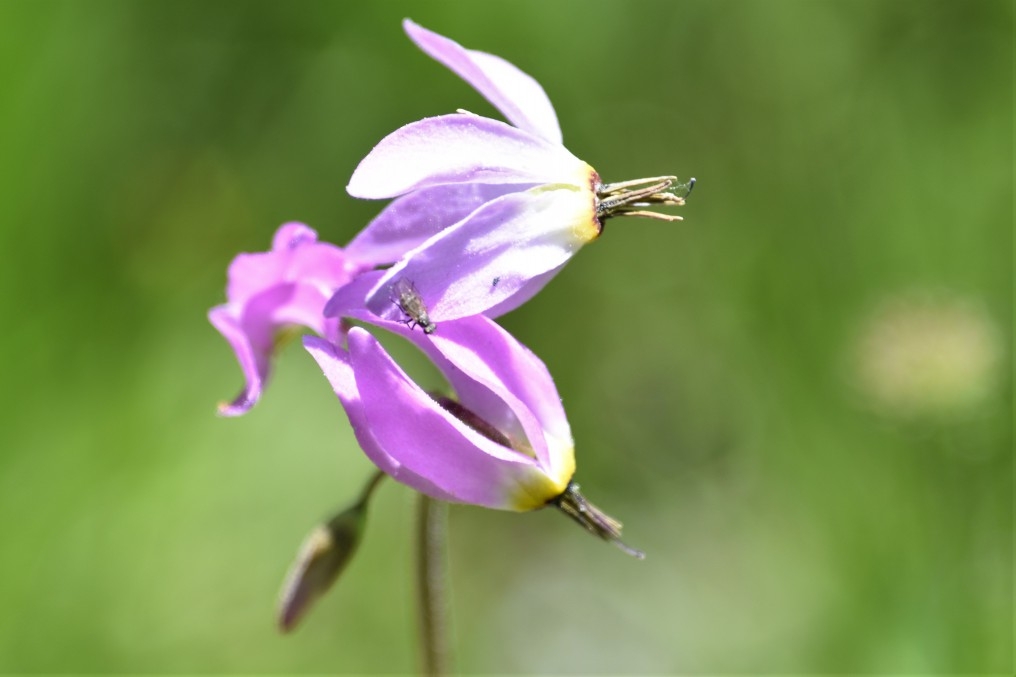 I recognize Indian paintbrush, some variation of golden stars, lupines, shooting stars, something that resembles a poppy, at least four species of grass, purple tube flowers, red tube flowers, white bells and many more. I pick up on the strong sweet scent of sage. I find the plant, pick a few leaves, crush them, and inhale. I love that smell. I see a few mushrooms here and there, white shelf mushrooms growing out of damaged or dead trees. I’m surprised to see any at all at this elevation. The same trip back takes a little over four hours. But then again, I have a battery in my ass, so to speak.
I recognize Indian paintbrush, some variation of golden stars, lupines, shooting stars, something that resembles a poppy, at least four species of grass, purple tube flowers, red tube flowers, white bells and many more. I pick up on the strong sweet scent of sage. I find the plant, pick a few leaves, crush them, and inhale. I love that smell. I see a few mushrooms here and there, white shelf mushrooms growing out of damaged or dead trees. I’m surprised to see any at all at this elevation. The same trip back takes a little over four hours. But then again, I have a battery in my ass, so to speak.
